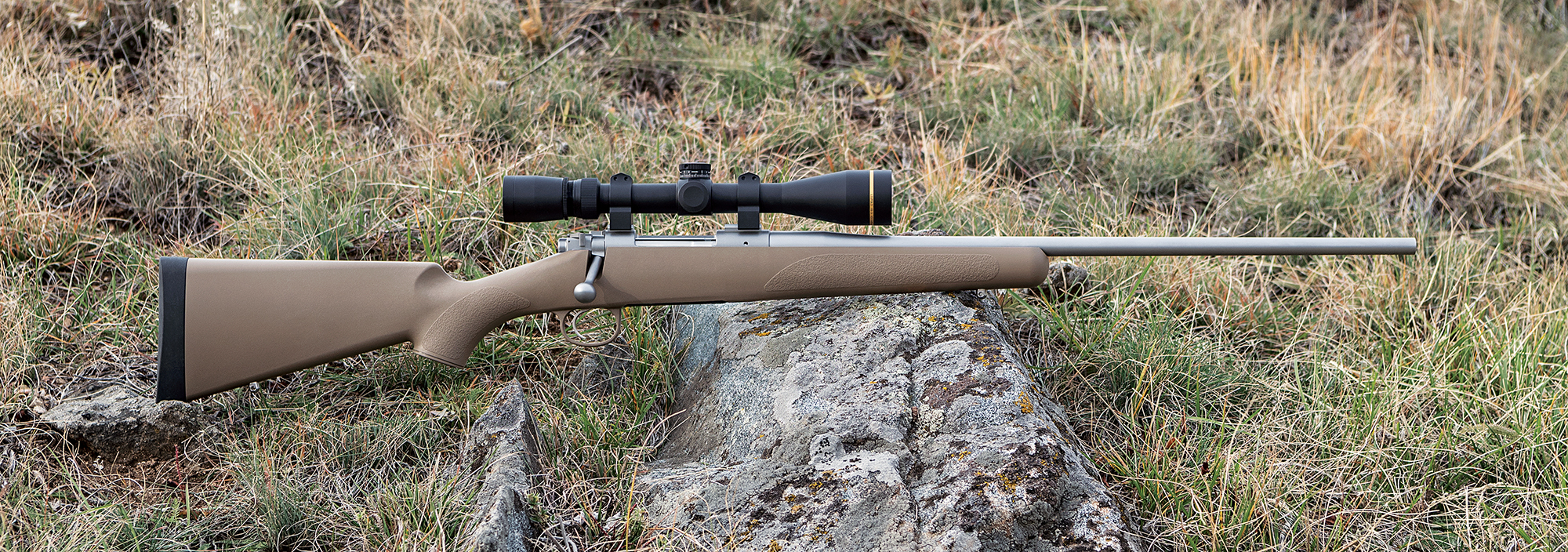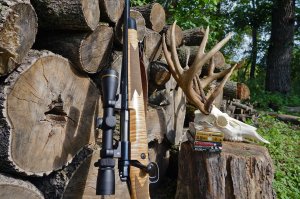We may earn revenue from the products available on this page and participate in affiliate programs. Learn More ›
Every major rifle company makes a bolt-action that seeks to deliver high performance to shooters who are either on a budget or afflicted with Yankee-like stinginess. The Kimber M84 Hunter is one of the more recent additions to this trend.
The Hunter isn’t vying to be the cheapest rifle on the rack at your local superstore. That’s probably a wise move, as the company has worked hard to cultivate a certain cachet among its customers and those who aspire to own a firearm engraved with the Kimber logo’s script lettering. The rifle retails around $799, which keeps it out of the bargain-basement category while remaining attainable to a large percentage of the shooting populace. The most costly component of the Hunter is the M84 action. This is the sleek Mauser-style two-lug action that has become synonymous with Kimber’s rifles and is the reason for much of their popularity.

CLASSIC DESIGN
As any proper Mauser action should, the M84 has a full-length claw extractor that grabs hold of the rim of the cartridge brass as it is stripped from the magazine and doesn’t let go until the shell is pulled free from the chamber. The extractor is designed so that it will slip over the rim of a cartridge being single-fed into the action as well, allowing for easy feeding at the bench or after the rifle’s magazine has run dry. The action features a well-designed three-position safety that physically moves the firing pin toward the rear, disengaging it from the trigger’s sear, while also preventing the trigger from moving.
As with all three-position safeties, the middle setting allows the action to be opened and a shell to be unloaded with the rifle still on safe. But the M84’s safety does more than that. Remove the bolt from the action with the safety in the middle position—which is done by depressing the small release tab on the left side of the receiver—and the firing pin/bolt shroud assembly can be unscrewed from the bolt body. This allows for quick and easy servicing in the field. The trigger on my sample came from the factory set to 3 pounds 9 ounces, but it is user-adjustable if you feel up to removing the action from the stock. It had no perceptible takeup and broke cleanly.
The ejector is a spring-loaded blade that rides up through a slot in the bolt face and kicks brass free with a force dependent on how hard the shooter works the bolt.
MAGAZINE ISSUES
The rifle is fed by a detachable box magazine that has a flat bottom and sits flush within the stock. A release tab is located at the forward end of the magazine and doesn’t protrude from the stock, meaning there’s little chance the magazine could be inadvertently knocked loose by catching on a stray branch or an improvised rest in the field. The stock has a generously sized notch where the release tab sits to accommodate a gloved finger, making it easy to remove the magazine.
I had three magazines at my disposal for this test: one that came with the rifle and two extras supplied by Kimber. The one that came in the rifle didn’t work very well. It was difficult to load to capacity (3 rounds) in 6.5 Creedmoor, which is what my rifle was chambered in. This caused the rifle bolt to drag on the top cartridge and made cycling the gun a chore. The second magazine worked a bit better, but it was still a bit sticky. The third magazine worked just fine.
I doubt this is a systemic issue with the Hunter, but as always, caveat emptor is a good principal to follow.
During the shooting drills that are part of Outdoor Life’s testing protocol, which include running the rifle rapidly with a full magazine from various practical field positions, I used only the third magazine.
LOADS TESTED
The accuracy was typical for a lightweight rifle of this type. I shot four different factory loads through the Hunter—two from Nosler (140-grain BTHP Match and 140-grain Ballistic Tip), and two from Hornady (120-grain A-Max and 120-grain GMX). My 5-shot groups averaged 1.687 inches, with the best group being a .829-inch cluster with the GMX, which is an outstanding hunting bullet I’ve used in the past in 6.5 CM on game up to, and including, giant eland in Africa. The rifle did show some flashes of brilliance at the bench, however. Several times I ended up with three shots touching, but then the rifle would throw the next couple of bullets wide.

LIGHT AND NIMBLE
Unscoped, the rifle weighs 5 pounds 7 ounces, which makes it very handy to carry in the field, especially when paired with a light scope, like the Leupold VX3i 4.5–14x40mm I mounted on it.
The rifle is stocked with Classic American dimensions, meaning a flat comb and straight forend that tapers in parallel with the barrel. Both the forend and grip have pebbled texturing on either side that works well, but it would be better if it were a bit more aggressive. The matte silver finish on the metal contrasts nicely with the tan stock. Overall, it is a good-looking gun that is handy, reasonably accurate, and, other than the issue with the magazine, performed well.



